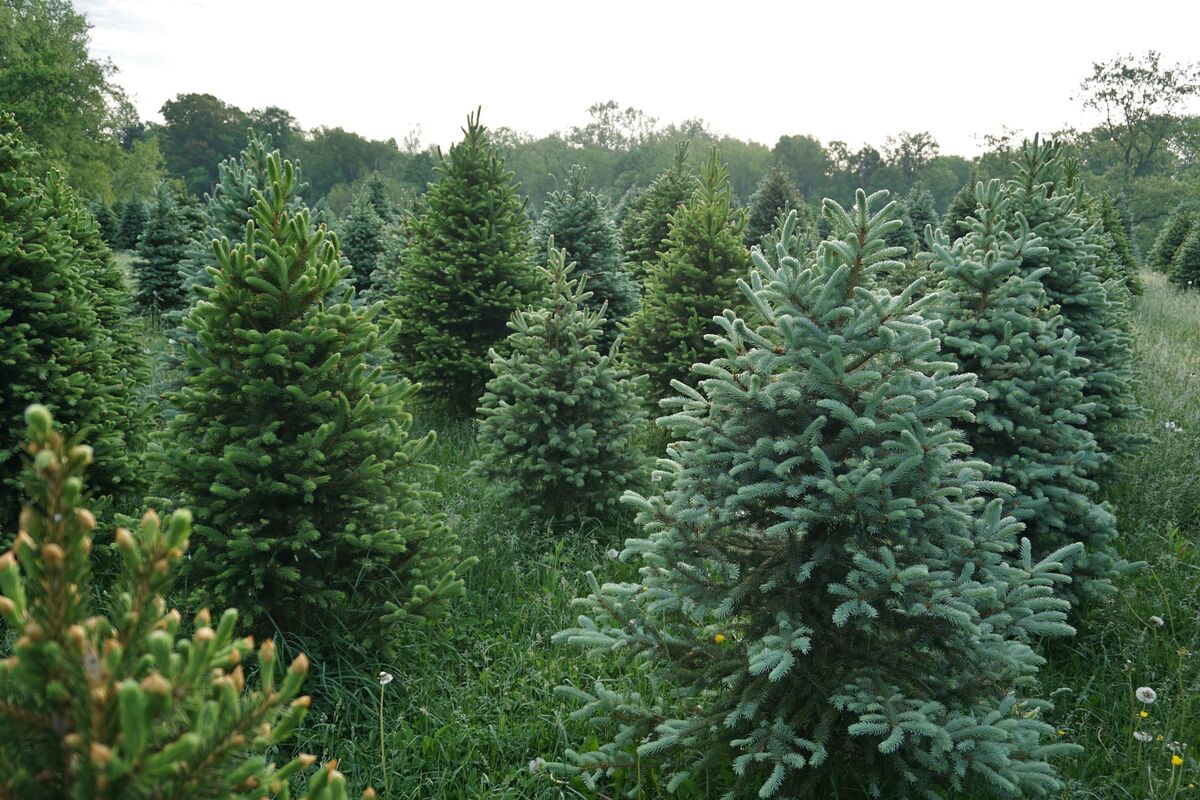Home>Gardening News and Trends>Latest News>What Does The Bible Say About Christmas Trees


Latest News
What Does The Bible Say About Christmas Trees
Modified: January 22, 2024
Discover what the Bible has to say about Christmas trees in our latest news article. Explore the significance and historical roots of this festive tradition.
(Many of the links in this article redirect to a specific reviewed product. Your purchase of these products through affiliate links helps to generate commission for Chicagolandgardening.com, at no extra cost. Learn more)
Table of Contents
Introduction
Christmas trees have been a cherished tradition for centuries, adorning living rooms and town squares during the festive season. These evergreen trees, adorned with ornaments and lights, are a symbol of joy, unity, and celebration. But what does the Bible say about Christmas trees? Are they purely a secular tradition or do they have a deeper meaning rooted in religious beliefs?
The history of the Christmas tree dates back to ancient times, long before the birth of Jesus Christ. Evergreen trees were revered by various cultures for their ability to withstand harsh winters and symbolize eternal life. In the Christian context, the Christmas tree has evolved to represent the tree of life mentioned in the Bible.
Throughout history, Christians have debated the theological implications of incorporating a Christmas tree into their celebrations. Some argue that it is a pagan symbol that goes against biblical teachings, while others believe that it can be a meaningful way to honor the birth of Jesus.
In this article, we will explore the history of Christmas trees, examine the symbolism associated with them in the Bible, and consider arguments both for and against them from a biblical perspective. It is important to note that this article aims to provide a comprehensive understanding of the topic and does not aim to dictate anyone’s personal beliefs or practices.
So, let’s dive deeper into the fascinating world of Christmas trees and discover what the Bible truly says about them.
History of Christmas Trees
The origins of the Christmas tree can be traced back to ancient civilizations, where evergreen trees symbolized fertility, rebirth, and the enduring spirit of life. The practice of bringing evergreen branches indoors during the winter solstice was common among the ancient Egyptians, Romans, and Norsemen as a way to celebrate the return of the sun and the promise of spring.
The modern tradition of the Christmas tree began in Germany during the 16th century. It is said that Martin Luther, the Protestant reformer, was the first to add lighted candles to a Christmas tree. Legend has it that while walking through a forest one winter evening, Luther was struck by the beauty of the starlight shining through the tree branches. Inspired by this sight, he brought a tree into his home and adorned it with candles to replicate the scene for his family.
Over time, the custom of decorating Christmas trees spread throughout Europe. It gained popularity in England during the reign of Queen Victoria and Prince Albert in the 19th century. The royal couple was depicted in a popular newspaper illustration standing next to a decorated Christmas tree, which helped to popularize the tradition in English-speaking countries.
German immigrants brought the tradition of the Christmas tree to America in the 18th and 19th centuries. Initially, the custom was seen as pagan and was met with resistance. However, as more and more Americans embraced the festive tradition, the Christmas tree became an integral part of holiday celebrations across the country.
Today, Christmas trees are a ubiquitous symbol of the holiday season, with various types of artificial and real trees available for purchase. Families gather to decorate their trees with lights, ornaments, and tinsel, creating a warm and festive atmosphere in their homes.
The history of the Christmas tree is a testament to the enduring nature of traditions and the ability of cultures to adapt and evolve over time. While the origins of the Christmas tree may be rooted in ancient customs, its significance and symbolism have evolved to reflect the customs and beliefs of different societies.
Symbolism of Christmas Trees in the Bible
While the Bible does not specifically mention Christmas trees, there are several symbolic elements associated with trees that can be found throughout its pages. These symbols can help us understand the significance of the Christmas tree in the context of Christian beliefs.
1. Tree of Life: In the book of Genesis, the Bible mentions the Tree of Life, which was located in the Garden of Eden. This tree symbolized an eternal connection with God and the gift of immortality. The Christmas tree can be seen as a representation of this Tree of Life, reminding believers of the promise of eternal life through faith in Jesus Christ.
2. Evergreen Tree: Evergreen trees, which stay green throughout the year, have been associated with life and renewal in various cultures. In the Bible, the evergreen tree can be seen as a symbol of God’s unchanging love, faithfulness, and eternal presence. Just as the evergreen tree remains steadfast in the midst of winter, believers are encouraged to trust in God’s constant presence in their lives.
3. Light: One of the key elements of Christmas tree decoration is the addition of lights. In the Bible, light is often used symbolically to represent God’s presence, guidance, and the victory of good over evil. The lights on the Christmas tree can serve as a reminder of Jesus, who is described as the “light of the world” in the New Testament. Just as the lights bring warmth and brightness to the tree, believers are called to let their light shine before others and reflect the love of Christ.
4. Joy and Celebration: The Christmas tree is often associated with joy and celebration during the holiday season. In the Bible, trees are mentioned as a symbol of rejoicing and praise. For example, the prophet Isaiah speaks of the future restoration of Israel, likening it to a joyful tree that will bear fruit and flourish. The Christmas tree, with its festive decorations and joyful atmosphere, can be seen as a symbol of the joy and celebration that comes with the birth of Jesus Christ.
It is important to note that the symbolism associated with the Christmas tree may vary among different Christian denominations and individual interpretations. While these symbolic connections can provide a deeper meaning to the tradition, it is ultimately up to each individual to discern the significance of the Christmas tree in their own faith journey.
Arguments Against Christmas Trees from a Biblical Perspective
While Christmas trees have become a beloved symbol of the holiday season for many, there are some who hold reservations about their use from a biblical perspective. Below are a few arguments that have been presented against the inclusion of Christmas trees in Christian celebrations:
1. Pagan Origins: One of the main concerns raised is the pagan origins of the Christmas tree tradition. Opponents argue that bringing evergreen trees indoors and decorating them with lights and ornaments stems from pre-Christian practices that worshipped nature. They believe that Christians should avoid any practices that have pagan roots, regardless of how they may have evolved over time.
2. Idolatry: Some individuals argue that the decoration of Christmas trees can border on idolatry, as they can become the focus of excessive attention and adoration during the holiday season. They believe that the Bible strictly prohibits the worship of anything other than God, and that the exaltation of a decorated tree can detract from the true meaning of Christmas, which is the birth of Jesus Christ.
3. Distraction from Worship: Another concern is that the presence of Christmas trees in churches and homes can distract believers from the true worship of God. Critics suggest that the emphasis on the physical aspects of the holiday, such as decorations and gift-giving, can overshadow the spiritual significance of the season and divert attention away from the teachings of Jesus.
4. Misrepresentation of Christianity: Critics argue that the inclusion of Christmas trees in Christian celebrations can misrepresent the true message of Christianity. They believe that the focus should be on the birth, life, death, and resurrection of Jesus, rather than on secular traditions and symbols. By prioritizing the Christmas tree, they argue, believers risk diluting the fundamental teachings of their faith.
It is worth noting that while these arguments exist, they represent the perspective of a minority within Christian circles. The majority of Christians who incorporate Christmas trees into their celebrations do so as a way to express their joy, unity, and appreciation for the birth of Jesus Christ.
Ultimately, the decision to include or exclude Christmas trees from Christian practices is a matter of personal conviction and interpretation of biblical teachings. It is important for each individual to prayerfully consider their own beliefs and seek guidance from their faith community in order to make an informed and conscientious decision.
Arguments in Favor of Christmas Trees from a Biblical Perspective
While there are varying opinions on the use of Christmas trees in Christian celebrations, many believers find value and meaning in incorporating them into their holiday traditions. Here are some arguments in favor of Christmas trees from a biblical perspective:
1. Symbolic Representation: Proponents argue that the Christmas tree can serve as a symbolic representation of important biblical themes. They see the evergreen tree as a reminder of God’s eternal love and faithfulness. The lights on the tree can symbolize Jesus as the light of the world, bringing hope and joy to believers. The decorations can be considered a reflection of the beauty and diversity of God’s creation.
2. Family and Community Bonding: Decorating the Christmas tree can be a meaningful family activity, fostering a sense of unity and togetherness. It provides an opportunity for parents to share the story of Jesus’ birth and the significance of Christmas with their children. Additionally, community events centered around the lighting of a Christmas tree can bring people together and promote a spirit of goodwill and fellowship.
3. Honoring Tradition: For many Christians, the Christmas tree is a cherished tradition that has been passed down through generations. It connects them to their cultural heritage and provides a sense of continuity in their faith journey. The use of a Christmas tree in celebrations can serve as a way to remember and honor the rich history and traditions of Christianity.
4. Personal Expression of Faith: Christmas trees can be seen as a personal expression of faith and love for Jesus. Believers view the tree as a way to visually celebrate and honor the birth of Christ, expressing gratitude for God’s gift of salvation. Through the act of decorating the tree, individuals have the opportunity to reflect on the significance of Jesus’ birth and the impact it has had on their lives.
5. Outreach and Evangelism: Some Christians view the Christmas tree as an opportunity for outreach and evangelism. By displaying a tree adorned with symbols and ornaments that reflect the Christian faith, believers can engage in conversations with others about the true meaning of Christmas. It can serve as a starting point for sharing the gospel and inviting others to experience the love and grace of Jesus.
It is important to acknowledge that the use of Christmas trees is a matter of personal preference and not a requirement of biblical faith. Christians who choose not to include a tree in their celebrations should be respected in their convictions, just as those who choose to have a tree should not be judged for their practices.
In the end, the inclusion of Christmas trees in Christian celebrations should be guided by a sincere desire to honor and glorify Jesus Christ, recognizing that the true essence of Christmas lies in the birth of our Savior.
Conclusion
The debate surrounding the inclusion of Christmas trees in Christian celebrations is a complex and multifaceted one. While some individuals argue against their use due to concerns about pagan origins, idolatry, distractions from worship, and misrepresentation of Christianity, others find value and symbolism in incorporating Christmas trees into their holiday traditions.
It is important to recognize that the Bible does not explicitly endorse or condemn the use of Christmas trees. However, various symbols and themes associated with trees in the Bible can be interpreted to provide meaning to the presence of Christmas trees in Christian celebrations.
Ultimately, the decision to include or exclude Christmas trees from one’s personal or community practices is a matter of individual conviction and interpretation of biblical teachings. Christians are encouraged to prayerfully reflect on their beliefs, seek guidance from their faith community, and approach the topic with understanding and respect for differing viewpoints.
Regardless of one’s stance on Christmas trees, it is essential to remember that the true significance of the holiday lies in the birth of Jesus Christ. Whether a Christmas tree is present or not, believers should strive to center their celebrations on the love, grace, and hope that Jesus brings to the world.
As the holiday season approaches, may we all embrace the spirit of unity, generosity, and joy, seeking to honor God and share the message of Jesus’ birth with others. Whether adorned with ornaments and lights or celebrated in other meaningful ways, may this festive season be a time of reflection, gratitude, and renewed commitment to living out the teachings of Christ.








